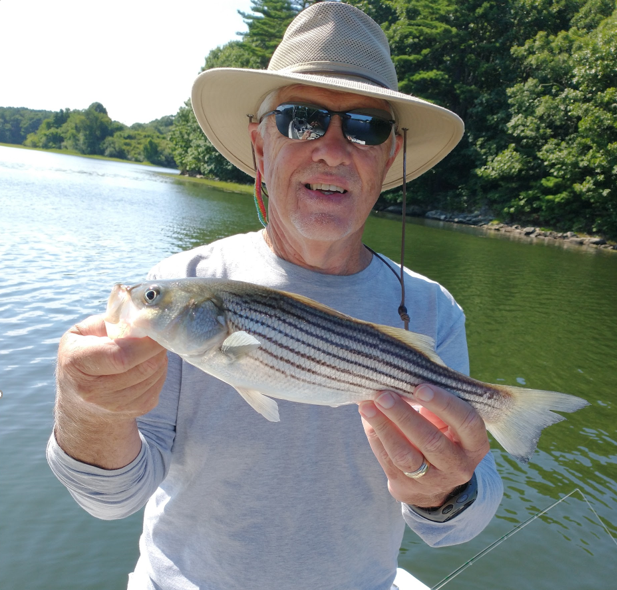WRITING ON THE FLY,
By GEORGE LISET
Fly fishing for striped bass, aka stripers, can be the highlight of summer fishing, so when my friend and New Hampshire guide John McKernan put the bug in my ear to head out to try our luck, I jumped at the chance. John has been my fly fishing mentor. John is partly responsible for my fly fishing addiction.
John taught an Outdoor Education class at Dover High School, which included a fly fishing introduction and a trip to the Cocheco River, which I would assist with on occasion. John is a great teacher and a student favorite and was always willing to help me with my casting.
John and I set a time and I went up to my den to look for my striper rod. There are different sized fly rods for different sized fish. Smaller weight rods for smaller fish like brook trout and bigger rods for big game fish like marlin and sharks. After about thirty plus minutes of frustration of not finding my 8-weight rod, I remembered I had given it to my son.
I came across another 8-weight rod that I had bought at the big fly fishing show in Marlborough, Mass., before the pandemic, but I didn’t have a reel or a line. I took a quick trip over to Eldredge Brothers Fly shop and talked to store manager Jim Bernstein. Jim is a long-time fly fisher and is very knowledgeable about all facets of the sport. Jim and I talked about 20 minutes before I even told him why I was there.
Jim set me up with a nice economical Lamson Liquid Vapor 8-weight reel. After we discussed for another ten minutes my options for a line, we decided on a Rio Slick Cast 250 grams sinking line since I would be fishing out of a boat. Jim mentioned that some fly fishers will bring two rods with them. The second fly rod is loaded with a floating line in case there is some top water action. My third choice of line would have been an intermediate line for fly fishing from shore.
I met John at his boat at the small marina on Dover Point Road. It was a beautiful day. There was a light breeze and the humidity had broken. It was a perfect day. All we needed was for the fish to cooperate. We loaded up our gear and headed out under the General Sullivan Bridge down the Piscataqua River in search of stripers. The upper part of the river was pretty muddy from all the rain. Look for the birds and they will tell you where the fish are.
The stripers will travel in schools and will surround a group of bait fish and create a bait ball, then the stripers will attack them. The dead or wounded will float to the surface and the Terns and Seagulls will dive to the water’s surface to get a free meal. Since we didn’t see any birds we both tied on a Banjo Minnow and started trolling our way down the river.
The fishing started off slow. Finally as we worked our way down toward Elliot, Maine, John caught a Pollock. Then it was my turn to get one, but we still hadn’t seen any stripers. As we trolled down the mouth of Portsmouth Harbor John caught the first couple of stripers. Now the pressure was on.
We worked our way down to Rye and then the action got fast and furious. John and I started catching stripers two at a time. It was non-stop action for the next few hours. John had asked me how my casting was. I said it needed work. I admitted that I had mostly been nymph fishing as of late and mostly working small streams and rivers.
John talked about the better you can cast, the more fishing options you have, especially from a boat. As we got out of the Piscataqua, the water cleared, and we began to see the birds. All of a sudden, about 40 yards away the water boiled with jumping fish. John had me try and cast to the spot. My first effort came up short. My second effort decorated the bow of the boat with sinking line.
John looked over at me with a smile and said it was time for more casting lessons. John mentioned that trying to move an 8-weight sinking line with a heavy fly on the end is a different beast, but nothing we couldn’t fix. That’s what I enjoy about John, he is the consummate teacher. As we headed back in to beat the tide, we figured our biggest fish were between 16-18”.
The best part of having a friend who is a guide is that they put you on to fish. There are a number of knowledgeable guides on the Seacoast. They are worth every penny. They are not as much as a day at Disney and you don’t have to fight crowds. The views from a boat are incredible and stripers are a blast. There is still plenty of summer left, so enjoy!
George Liset of Dover is an outdoor writer and avid fly fisherman who shares insights of his time on the water exploring New Hampshire streams and rivers as well of those around New England. George is a graduate of Wheaton College, Illinois, and the University of New Hampshire.
Credit: Source link






























